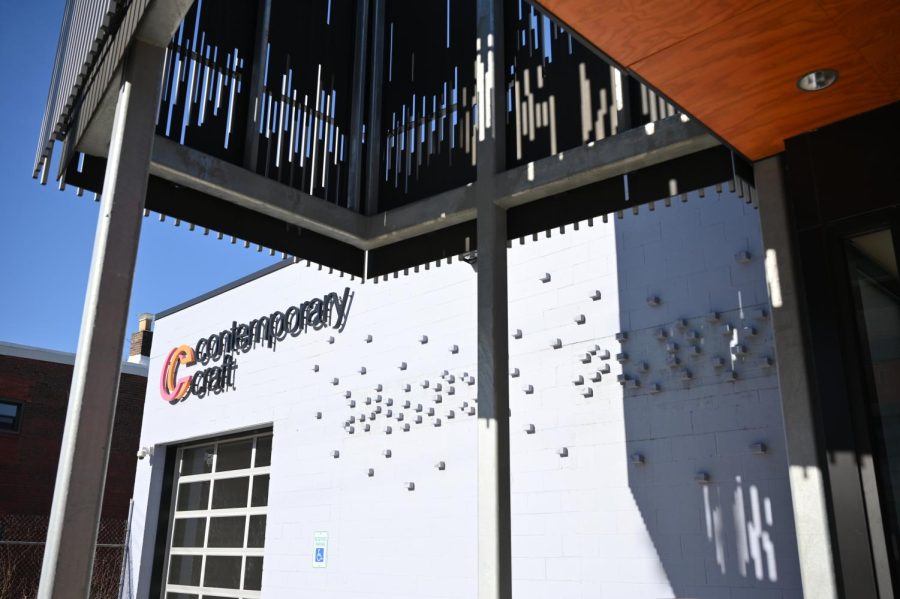Contemporary Craft exhibit brings internationally recognized glass artists together
Nate Yonamine | Senior Staff Photographer
Contemporary Craft, an art gallery in Lawrenceville that is hosting a new exhibition, “Transformation 11: Contemporary Works in Glass.”
January 18, 2023
Michael Janis, an artist and the co-director of the Washington Glass School, said the artistic medium of glass is often more complex than others.
“Glass is a seemingly untameable medium which continually finds itself in the lingering discourse of art versus craft,” Janis said.
Contemporary Craft, an art gallery in Lawrenceville, is using glass to push traditional barriers of art and reveal the extraordinary. The gallery’s most recent exhibition, Transformation 11: Contemporary Works in Glass, features 17 international glass artists who are taking a modern approach to the age-old craft. The exhibit runs through March 18.
Rachel Saul Rearick, Contemporary Craft’s executive director, said the organization aims to highlight exceptional art through the glass art exhibit.
“Transformation recognizes an emerging or mid-career artist with a $5,000 prize and exhibition feature, along with a professionally produced video focusing on their artist practice,” Rearick said.
Some glass art features idiosyncratic themes that go beyond just the medium itself. For contemporary glass artist David King, who is featured in the exhibition, his work focuses heavily on the concept of color.
“Making color systems manifests in a lot of different ways. I have been making sheet glass, using a variety of colors similar to the process that was used to make stained glass panels,” King, an art professor at Ohio State University, said.
King’s focus on color extends far beyond simply the colors of the rainbow. He said he takes a deeper and more scientific approach which incorporates how we see and perceive the world.
“Sculpture or installation is based on this idea of site and perspective and like a projection of color, whether that’s real or virtual or implied.” King said. “Johann von Goethe wrote this book called The Theory of Colors, where he just studied color phenomena and recorded it. It was sort of an opposition to these systems and ideas that Newton had established.”
King received an honorable mention for his work for the 2022 Elizabeth R. Raphael Founder’s Prize at Contemporary Craft.
Another theme captured in this exhibition includes identity and the perception of self. Janis’ work focuses on portraiture through the lens of culture, time and family.
Janis is directly inspired by his experiences as a multicultural child and the struggles he and his family faced when assimilating to life in Chicago, Illinois. He said he addresses a plethora of themes in his work.
“At the core of my artwork is pure portraiture, but great focus on the disharmony of the self and perception,” Janis said. “I try to conjure scenes and feelings that evoke the slipperiness of memory, longing and an anxious curiosity.”
According to the Contemporary Craft website, the very process that creates glass is breathtaking. When sand meets extreme heat, their powerful interaction produces a beautifully intricate and three-dimensional medium. Each featured artist’s distinct creative processes show a deep appreciation for the natural medium.
King said he finds that the creative process is more abstract than people may think.
“The creative process is quite mysterious,” King said. “Sometimes there’s a moment of inspiration. You see something and it’s completely materialized. I’m inspired by the process, trying things, putting things together. Sometimes glass blowing is thought of as a dance because we’re often working with multiple people. It’s a bit of a creation.”
Janis added that he views the collaborative aspect of glassmaking similarly to King.
“I like engaging others with what I make, and incorporating both abstract and representational forms gives me the ability to tell stories and make the artwork something not just by me, but of me,” Janis said. “I have an almost obsessive focus that served me well when I was an architect, and now allows me to sit for hours maneuvering frit powder into intricate forms that populate my narratives.”
But sometimes the kiln has an idea of its own, he said.
“I’ve come to accept this result as a kind of organic quality that is part of the firing process. To cover my bases, I do a mojo dance to appease the kiln gods for a successful firing,” Janis said.








